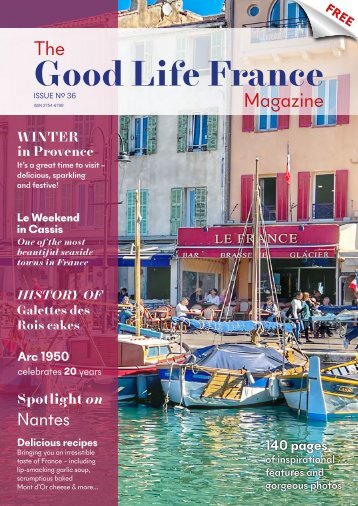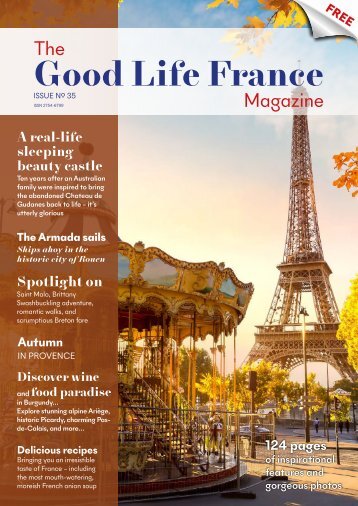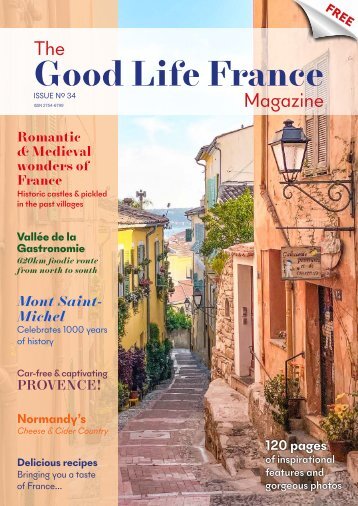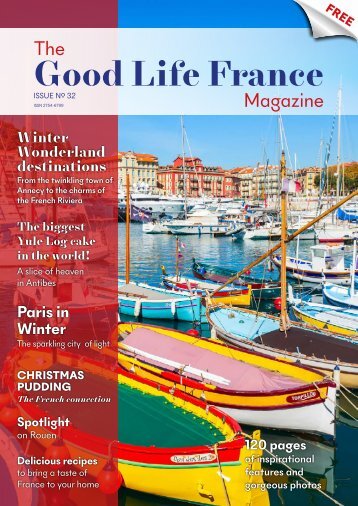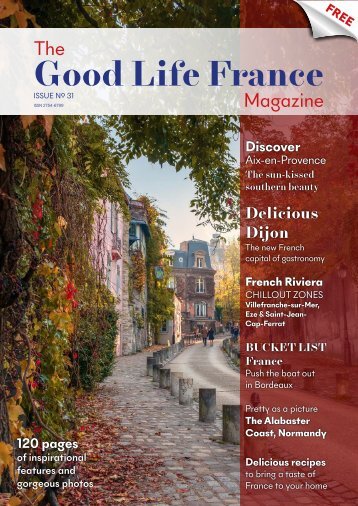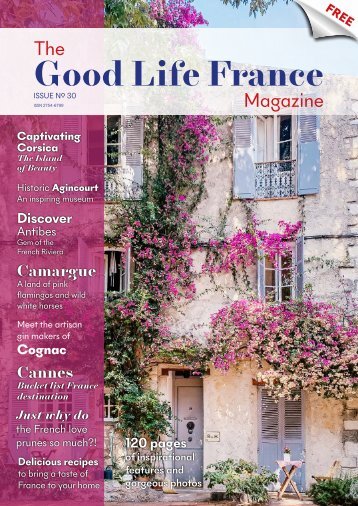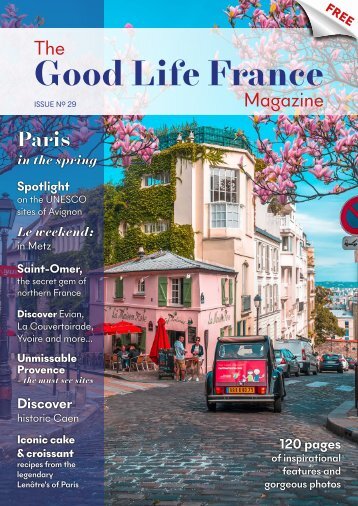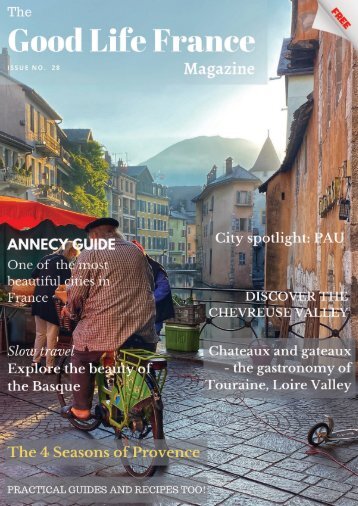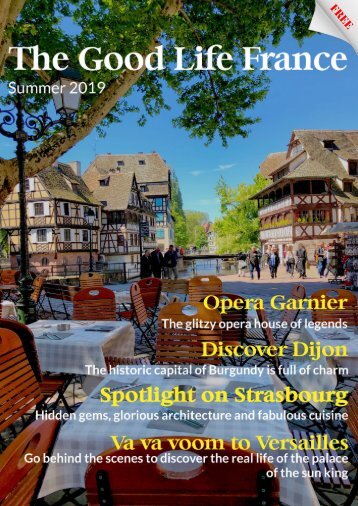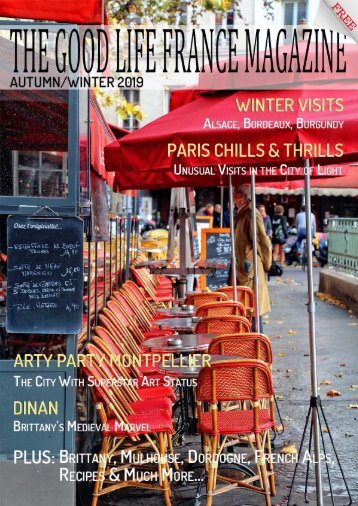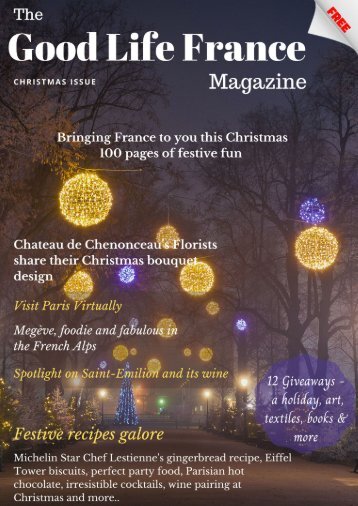
The Good Life France Magazine
The Good Life France Magazine brings you the best of France - inspirational and exclusive features, fabulous photos, mouth-watering recipes, tips, guides, ideas and much more...
Published by the award winning team at The Good Life France
Issue No. 19
Chateau de Sully,
Chateau de Sully, Saone-et-Loire Madame de Sévigné, a 17th century aristocrat famous for recording daily life through copious letters, called the courtyard of the Chateau de Sully “the most beautiful in France”, and she wasn’t wrong. It is a huge space, perfect for partying aristos and surrounded by the walls of the fabulous castle. The gorgeous courtyard (photo page: 8-9) was designed by Gaspard de Saulx-Tavannes, a favourite of Queen Catherine de Medici. The Chateau is perhaps not as well-known as it ought to be as it is in the middle of beautiful burgundy countryside, around 35km from Beaune, but it's well worth the effort to visit and explore the beautiful grounds and interior. Built around 1567, this is no museum chateau, in fact it’s still lived in by Madame la Duchesse de Magenta, Marquise de Mac Mahon. It has a pinch of medieval, a dash of Renaissance and is elegant and pretty as a picture. Surrounded by a moat fed by the River Drée, you cross a five arch bridge to enter the castle passing by what look like giant, ancient stone chess pieces. In fact they are symbols of the pride of a previous owner who on being made a Marquis celebrated by ordering the great stone sculptures of artefacts that feature on a marquis' coronet. The castle has been in the Mac Mahon family for several generations after Jean Mac Mahon, an Irish doctor married an heiress who inherited the castle. It was the home of Patrice de Mac Mahon, President of France from 1875-1879. The Duchess who hails from Scotland, married the Duke of Mac Mahon and it is she who lives there with her children and manages the vast estate ensuring the castle’s well-being. You’ll often spot her flitting about the castle and gardens followed by her excitable, friendly dogs. Inside the rooms are furnished with family heirlooms.
The family have hardly changed anything but maintained the integrity and historic beauty of the chateau for future generations. There’s no central heating and in a big castle like this, it can get very cold in the winter. “We have hot water bottles” says the Duchess laughing. Thanks to this determination to keep the chateau authentic, a guided tour reveals the exquisite footprints of history in every room. Unlike some chateaux the French Revolution didn’t leave its mark. Legend has it that the when the revolutionaries arrived to take the widowed Marquise to prison, the family explained that she was in her 80s and was dying and they persuaded the mob to come back when she had passed, which was predicted to be soon. The old lady did die a few weeks later but the canny family put her body in a barrel of brandy. When the revolutionaries returned, the family retrieved the body, put it in bed and pretended the old lady was still ill. The revolutionaries insisted on seeing her and agreed that she really didn’t look well. This went on until the French Revolution calmed down and the chateau survived. To this day says the Duchess, no one knows what day the Marquise actually died on, so they put 14 July 1978 on her grave. Guided visits are available daily (March to November), in English in summer months, and there are events throughout the year. It's especially kid-friendly with lots to do. Dont miss the delicious tea room and irresistible shop where you can buy the Estate's wine and fab souvenirs. www.chateaudesully.com Top: Amelie, Duchesse de Magenta with her sister Charlotte with some wine made from the Chateau's estate. Above: the incredible stone sculptures that represent the pieces from a Marquis' coronet
- Page 3 and 4: Bonjour! Summer is served in this i
- Page 5 and 6: contents P. 8 p. 25 P. 30 p 26 Feat
- Page 7: p. 62 p. 102 p. 54 p. 68 p. 78 Expe
- Page 10 and 11: The Secret World of Castles… Not
- Page 14 and 15: Château de Couches, Saône-et-Loir
- Page 17 and 18: Château d’Arlay, Jura, Franche-C
- Page 19: Citadel of Besanson, Jura The immen
- Page 22 and 23: The Calvados Experience You can fin
- Page 24 and 25: Chicken with Calvados Ingredients f
- Page 27 and 28: What's new for France in Summer 201
- Page 29 and 30: Lake Annecy to host Europe’s bigg
- Page 31 and 32: La Boumette, Paris From 22 June to
- Page 33 and 34: The best place to start exploring i
- Page 35 and 36: Photo: Diane Francis Cook Follow th
- Page 37: Throughout the year the city is als
- Page 40 and 41: Visiting the 12th century Abbaye No
- Page 43: Tours of the abbey are offered year
- Page 46 and 47: 1 Place du Capitole The Place du Ca
- Page 48 and 49: 6 See the sites Photo © Toulouse T
- Page 50 and 51: 12 Gourmet city 13 Bake my day With
- Page 52 and 53: 1- Festivals There are more than 10
- Page 55 and 56: The best markets in France - its of
- Page 57 and 58: Colmar Market Colmar, Alsace The ma
- Page 59 and 60: Royan Market Poitou-Charentes Held
- Page 62 and 63:
Photo © P Vincent ND Lourdes
- Page 64 and 65:
Photo © Studio GP Photos The giant
- Page 66 and 67:
Photo © Santuaries ND Lourdes P Vi
- Page 69 and 70:
Understated Luxury: The Coco Chanel
- Page 71 and 72:
While the designs are vintage, they
- Page 73 and 74:
Culture Vulture The Royal Basilica
- Page 75 and 76:
Locals love: The Abbesses district
- Page 77 and 78:
Lavender in Provence by Kim Rusche
- Page 79:
w a y s - WIN Click on the pic to e
- Page 82 and 83:
Mike created an enclosure for the s
- Page 84 and 85:
Mike is a walking encyclopaedia of
- Page 86 and 87:
Meet the Brits who run the best Lux
- Page 88 and 89:
When it was time to head home to th
- Page 90 and 91:
Never mind a pretty house, with spe
- Page 92 and 93:
Farms With land prices currently ve
- Page 95:
Do you have to be wealthy to benefi
- Page 98 and 99:
The Basics of Banking in France The
- Page 100 and 101:
Pre order M book at: Eat In the Fre
- Page 102 and 103:
Serves 6 Prep time: 20 minutes Bake
- Page 105 and 106:
Scrumptious Chestnut and Chocolate
- Page 108:
www.ofx.com
Inappropriate
Loading...
Mail this publication
Loading...
Embed
Loading...



